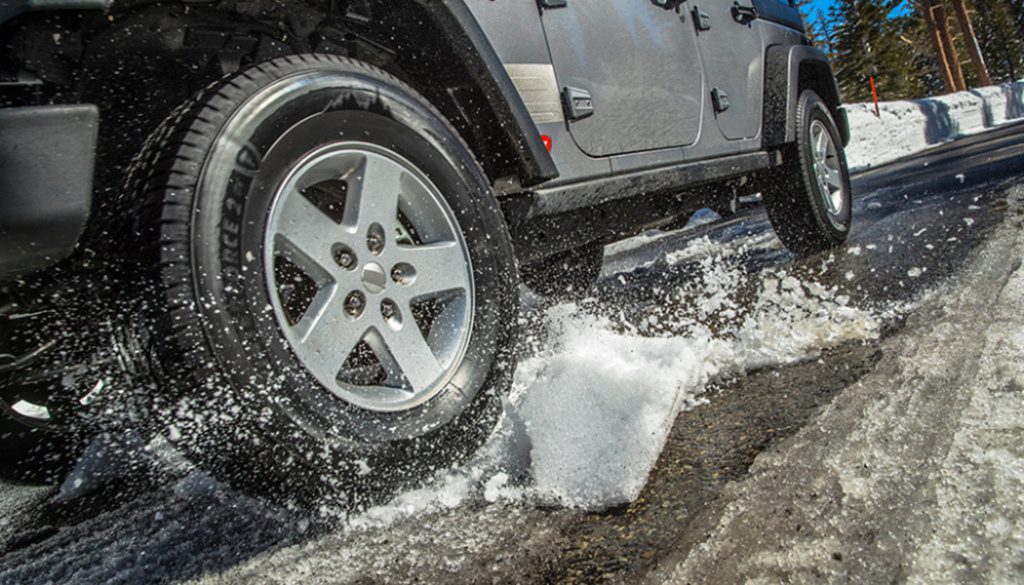All-Weather Tires: The Only Tire You’ll Ever Need…Maybe
All-Weather tires, another breakthrough in tire technology, or tire marketing?
In the 1970s the marketing guys at tire manufacturers came out with the All-Season tire and life was good. This rubber was advertised as a performer in all kinds of weather, extreme heat, wet surfaces, snow, extreme cold, and ice. And it was mostly true, except the snow, ice, and extreme cold parts. All-season tires can handle light snow and wet snow, but they lack traction in packed snow, are slicker than a hockey puck on ice, and tend to get brittle and crack in extreme cold.
And that of course, means you need to own and change out two sets of tires (all-season and winter tires) in great swaths of the country where the snow gets serious and the thaw doesn’t come until late April. All season tires are really 3 season rubber.
Three Peaks and a Snow Flake
For decades, Europe has had strict laws regarding the type of tire drivers had to use during winter. Basically, if you hit the road between October and April, the tires on your ride have to meet the Severe Snow Traction requirements. Tires meeting those standards have a symbol on their sidewalls that resembles three mountain peaks and a snowflake. For years, every vehicle in Europe needed two sets of tires. Finally, a manufacturer came up with a compound and tread design that met the stringent SST specs and was an excellent all-season rubber as well. Voila, all-weather tires were born.
Europeans can’t keep a secret, so the design and technology found its way to North America. Today there are more than 60 models of all-weather tires available domestically.
But are they really all weather? The best way to think about all-weather tires are as performance all-season or junior varsity winter tires. They all perform well on wet or dry surfaces in all temperatures and they can handle all but the most serious of winter weather. For a lot of people, they are the one tire solution.

All-Weather vs All Season
All-weather tires have many of the same characteristics as all-season rubber, so why would they be considered a performance model of an all-season? Performance all-season tires have a speed rating of V meaning they are good up to 149 mph. Tires with that rating have treads and compounds that can quickly dissipate heat generated from high-speed driving. They provide the grip needed to support enthusiastic driving.
All-weather tires try to build off the best qualities of all season and toss in cold weather capabilities that are lacking in the all-season tire. Here’s a quick list of all-weather advantages.
- All-weather tires bear the three peaks and snowflake logo indicating they have proven capabilities in severe weather conditions. All-season rubber doesn’t.
- The all-weather tread design includes asymmetrical chunky treads and deep sipes to grip ice and channel snow. Consumer Reports tested the distance it took to get to 20 mph in loosely packed snow. Winter tires took 58 feet, all-weather got there in 64 feet, and all-season tires needed 90 feet.
- The all-weather compound stays flexible at temperatures both above and below freezing allowing for more precise braking. All season compounds become stiffer and more brittle when exposed to freezing conditions making them less effective when braking on dry or snow covered surfaces in cold weather.
- When used year round, all-weather tires will generally last 50,000 miles which is comparable to some all-season tires. All winter rubber also runs quiet despite its chunkier tread design.
- Lastly, all-weather tires eliminate the need for winter tires and the biannual rite of rotating and balancing.
At the end of the day, if you live north of the Mason-Dixon line and you normally try to make it through winter on ordinary or performance all season rubber, you would probably benefit from a set of all-weather (and truly all-season) tires.
Who Makes These Things?
The short answer to that question is every brand you know and some you don’t. If you have a favorite brand of tire, they most likely have an all-weather model although you may have to dig through their web site to find it. Not all manufacturers have fully embraced the idea of promoting these tires as they may take a bite out of their all-season and winter tire sales.
Here’s a short list of all-weather rubber that get good ratings from consumers:
- Michelin Cross Climate®: These tires will range from $124 to $250 each depending on size and model. Key characteristics include an extreme silica compound that allows flexibility in both hot and cold temperatures, V-shaped tread pattern with full 3D depth sipes, and bevel edge tread blocks optimizing grip and braking on dry surfaces. These combined features make the Cross Climate® an excellent choice of rubber for snowy, wet, or dry conditions year round. The Michelin Cross Climate® comes with a 50,000-mile standard warranty.
- Goodyear Assurance WeatherReady®: This rubber runs about $127 per tire. Michelin uses silicon in its compound, Goodyear opts for Soybean oil to give its tread the flexibility to grip in wet, snowy, dry, or icy conditions. Its asymmetrical tread design has earned the Severe Snow certification. The tread on the WeatherReady® has a feature called Treadlock Technology® that locks the tread in corners and then opens on straightaways to provide maximum traction.
- Toyo Celsius: Toyo Celsius all-weather tires retail for about $127. This tire features a center tread of “snow claws” which are chunky, asymmetrical blocks banded on either side by multi-density sipes to provide traction on snow and ice. The outside tread are symmetrical with a lower sipe density separated by slush channels to optimize traction on wet surfaces. Generally speaking, these tires have excellent performance in snow, run quieter than most, and contribute to high fuel efficiency.
So, there you have it. If you swap out tires every year, and one set is ready for replacement, the all-weather tire just might end your twice a year ritual of paying for rotation and balancing.






